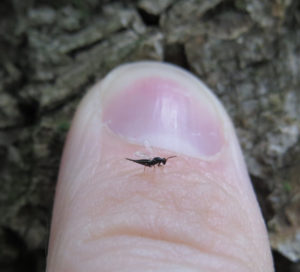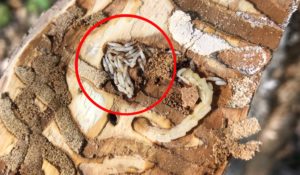Imagine that you waved a wand across your community and pollutants from hundreds of tail pipes and smoke stacks disappeared. Far-fetched, no? But that is what trees do every day, and a new tool could summarize some of the magic trees are performing to improve public health and infrastructure. Continue reading “Tree canopy cover benefits assessed using i-Tree Landscape”
Urban Forestry News
EAB biological control recoveries
By Bill McNee, forest health specialist, Oshkosh. bill.mcnee@wisconsin.gov; 920-360-0942
Tetrastichus planipennisi, an introduced, parasitic wasp that attacks emerald ash borer (EAB) larvae, was successfully recovered at two sites in Racine and Waukesha counties in October 2018. This was the first recovery of the natural enemy from Waukesha County. These events indicate that the wasps, released at the same sites in 2015, successfully established and have been attacking EAB larvae since then. This wasp species was previously recovered at release sites in six southeast Wisconsin counties (Kenosha, Milwaukee, Ozaukee, Racine, Walworth and Washington). These releases began in 2011 to reduce EAB populations over the long term, so that some small ash trees might reach reproductive maturity, thus allowing ash to persist on the landscape, albeit as a smaller, less common tree. The tiny wasps do not sting or bite people, and the public is unlikely to ever see them.

Adult Tetrastichus planipennisi wasp shown on a finger. Photo by Bill McNee.
Tree bark samples from the two sites are currently being incubated to look for another parasitic wasp, Oobius agrili, that may be present in EAB eggs. This species has not been recovered in prior surveys and is known to be more difficult to detect than T. planipennisi. Recovery surveys will continue at many locations 2-3 years after wasps are released to allow the populations of introduced parasitoids to increase to detectable levels.
It is important to note that insecticide treatment of high-value ornamental trees still needs to be done to prevent tree mortality from EAB. For more information about EAB, parasitoid wasps, and insecticide treatments, visit http://www.emeraldashborer.wi.gov.

Cluster of Tetrastichus pupae (circled) from a parasitized EAB larva, located near an unparasitized EAB larva. Photo by Bill McNee in Racine County, October 2018.
Reduce crime and violence with trees in your neighborhood
Can trees reduce aggression, violence and crime? Multiple studies say, “Yes!” October is domestic violence awareness month. Let trees be part of the solution. Levels of aggression and violence have been shown to be significantly lower among individuals who have some nearby nature outside their apartments than among their counterparts who live in barren conditions. Surveys exploring these results show residents with green views report using reasoning more often in conflicts with their children rather than violence. They also report less use of physical violence in conflicts with partners compared to those living in buildings without trees. Continue reading “Reduce crime and violence with trees in your neighborhood”
Celebrate your neighborhood trees this month
As the leaves begin to change from green to shades of orange, yellow and red, we celebrate the benefits these steadfast neighbors provide. October is NeighborWoods® Month, a campaign to plant and care for community trees. “Each year, tens of thousands of volunteers act to make their communities greener and healthier by planting trees – keeping their neighborhoods vibrant,” the Arbor Day Foundation reports.
Continue reading “Celebrate your neighborhood trees this month”
Foster student success with trees in your neighborhood
September is back to school month. How do you get those kids to settle down and focus after three months off? The answer is as simple as walking right outside your front door! Exposure to nature has shown various impacts on students, from improved academic performance and focus, to reduced Attention Deficit Hyperactivity Disorder (ADHD) symptoms. Research has shown exposure to nature during school hours is positively associated with academic performance, including standardized test scores, graduation rates, and plans to attend a four-year college. Continue reading “Foster student success with trees in your neighborhood”
Video to help understand urban forestry grant reimbursement
The Urban Forestry grant reimbursement process can be challenging. All the time and energy that goes into creating a successful project can also create a lot of paperwork, and it is not an easy task to keep everything organized. A new video has been created to help grant recipients navigate this aspect of the reimbursement process and avoid some of the most common mistakes that we see on our grant reimbursement forms. The video covers topics such as documenting cash expenditures, using correct equipment rates, and contacting DNR staff. It is approximately eleven minutes long and can be accessed from the Urban Forestry Grants webpage. Continue reading “Video to help understand urban forestry grant reimbursement”
Urban Forestry Council award nominations OPEN
The Wisconsin Urban Forestry Council, comprised of municipal employees, elected officials, nursery operators, and arborists, advises the Department of Natural Resources Division of Forestry on the best ways to manage urban and community forest resources. Every year, the Council bestows several awards to recognize and thank individuals and organizations across Wisconsin for their work and commitment to the trees, plantings, habitat and economic benefits they provide. Continue reading “Urban Forestry Council award nominations OPEN”
Tree City USA applications open
The application period for Arbor Day Foundation’s Tree City and Tree Campus USA programs opens September 4th! You can access information and application materials for these recognition programs from the DNR Urban Forestry website or the Arbor Day Foundation website. Tree City and Tree Campus applicants are encouraged to use the online application form, though hard-copy applications are available. These national award programs recognize efforts to raise awareness of the importance of trees and integrate trees and proper tree care in Wisconsin communities, around utility lines and facilities, and on college campuses. Continue reading “Tree City USA applications open”
Requiem for an Ash
The front moves and defenses are built, but there’s no doubt which way the war is going, and little doubt what is emerging the victor: a little green bug.
Agrilus planipennis, the emerald ash borer, has harangued and harassed North American forests since the late 1990s, and its journey across Wisconsin continues, county by county, city by city, tree by tree. But this is not its story. Continue reading “Requiem for an Ash”
2019 Urban Forestry grants now open!
A reminder that the application for the 2019 Urban Forestry Grants is open! Cities, villages, towns, counties, tribes and 501(c)(3) nonprofit organizations in or conducting their project in Wisconsin are encouraged to apply for a regular or startup 2019 Department of Natural Resources Urban Forestry Grant! The grants range from $1,000 to $25,000, and grant recipients must match each grant dollar for dollar. A startup grant of up to $5,000 is available for communities that want to start or restart a community forestry program. Grants are awarded to projects that align with state and national goals for increasing the urban forest canopy and the benefits it provides.
